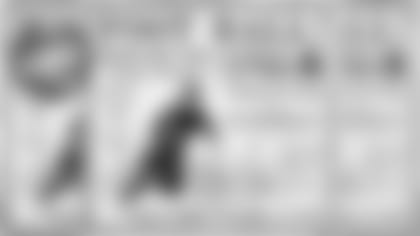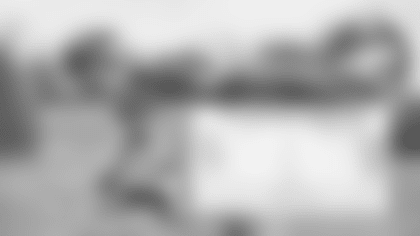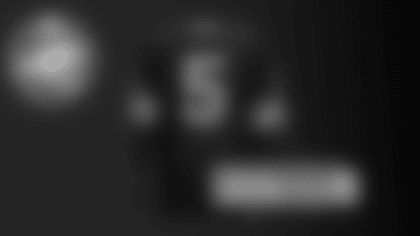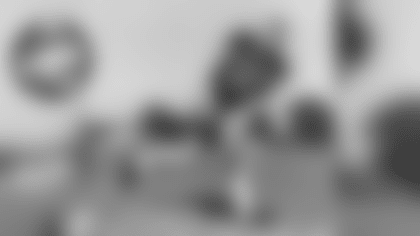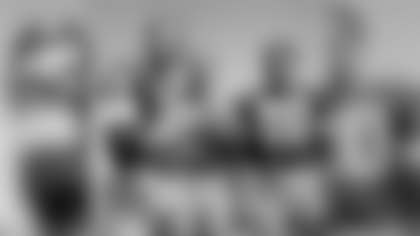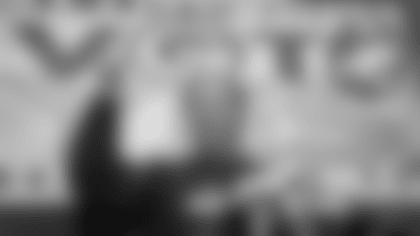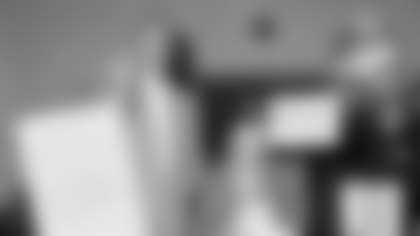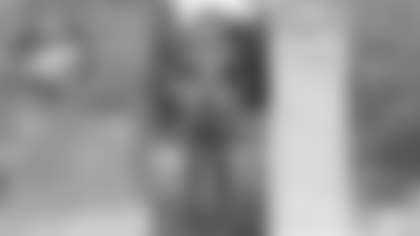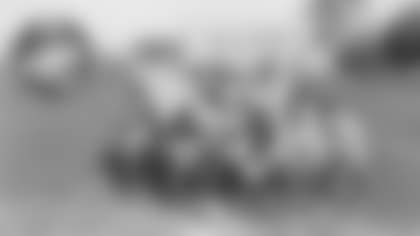Paul from Milwaukee, WI
My first cousins are Kliebhans. I noticed in the Packers media guide that one Adolph Kliebhan started the first NFL Packers game in 1921 at quarterback. Family lore has it that he played about one quarter and was replaced by Curly Lambeau. Adolph was reportedly a more regular player in 1919 and 1920. Do you have any more info on the first Packer QB? I'm also looking for his jersey number for that first game.
Yes, Adolph Kliebhan started at quarterback in the Packers' first American Professional Football Association (now the NFL) game on Oct. 23, 1921, against the Minneapolis Marines. George Calhoun wrote a detailed game story for the Green Bay Press-Gazette, but Kliebhan wasn't mentioned other than being listed as the starting quarterback and replaced by Lambeau. Based on Calhoun's story, the substitution took place in the first half.
I also found no mention of Kliebhan, other than being listed in the lineups, in the game coverage of The Minneapolis Morning Tribune, The Minneapolis Journal and the Minnesota Daily Star, along with The Milwaukee Journal and Milwaukee Sentinel. None of those papers covered the game, but they ran brief stories about it.
In July 2021, I answered a question about Kliebhan after receiving emails from a grandson and great grandson, where I largely addressed his role with the 1921 Packers. That can be found here.
As for Kliebhan playing with the 1919 and '20 Packers; no, he did not. However, he played at least one game with the 1922 Green Bay Boosters. The Boosters were organized that year, just as the Packers were in 1919, as an all-star team of Green Bay East and West alums. "The team (the Boosters) is composed of East and West side gridders, all of whom starred with their respective high school teams," the Press-Gazette noted on Sept. 29, 1922.
Here's what happened. In 1921, when the Packers started the season on Sept. 25, with a non-league game against the Chicago Boosters, 14 of their 21 players had played for either the 1919 or 1920 independent semipro Packers or both. But by the end of the 1921 season, only two of the 14 and three of the 21 were left.
Once the Packers started playing APFA games that season, they were under the constant threat of having to win or at least make it a close game to survive. Many of the APFA games were scheduled roughly week to week, and the weaker clubs that weren't competitive enough to draw good crowds struggled to find games and some even fell by the wayside.
Presumably, that had something to do with the Packers not playing their first APFA game until almost a month after the league opener. The Packers started with four non-league games against Rockford, the Chicago Cornell-Hamburgs and Beloit in addition to the Chicago Boosters.
Calhoun suggested as much after the second non-league game on Oct. 2, when he wrote, "the Green Bay Packers might bite the dust before the professional season is history…"
With those worries heading into the league opener against Minneapolis, the Packers started replacing their local high school products with recruits who had college and even some previous professional experience. And the turnover continued throughout the season. As I wrote in my four-volume history, "The Greatest Story in Sports," by the end of the 1921 season, the Packers were holding their practices in Chicago because their players were based across the Midwest.
Consequently, a year later, some of those displaced local Packers helped form the Boosters so they could continue to play football. Beyond that, the Boosters could have posed a serious threat to the Packers. They played their home games at Hagemeister Park or Joannes Park, which were adjacent at the time, and had mostly familiar Green Bay names in their lineup.
Tonawanda, N.Y., for example, lost its APFA team after one game because fans there were more interested in watching a team of local players than the ringers that had been brought in to play for the APFA team.
However, in Green Bay, it was the Boosters who didn't survive. In October, two days before a scheduled game at Sheboygan, the Sheboygan Press reported that the Boosters had backed out. "The Bay manager stated that his reason for cancelling the game was that the four backfield men, former Packers, have resigned from the team to play with other organizations…" Although the Boosters played two games after that, it appears their season ended in October.
As for Kliebhan, he apparently returned to Milwaukee, where he was born, and continued playing football. In 1925, I found an A. Kliebhan listed as the quarterback for Mi-Nash-A, a team associated with the Nash Motor Co., in a Milwaukee Amateur Football Association game. Even earlier, I found two Kliebhans – without first names or initials – listed in the lineup for the Bay Views in a MAFA Major League game against the Lapham A.C. on Oct. 20, 1919. A year later, the Packers played the Lapham A.C. as one of their 11 games.
As for Kliebhan's number, I don't believe the jerseys were numbered in 1921.
Michael from Appleton, WI
After recently reading your fascinating posting about the Acme Packers jerseys, I discovered that Heritage Auctions was offering a series (six) photographs of the 1921 Acme Packers. From the estate of Buff Wagner, the images clearly show the Acme uniforms. I assume I am not the only one who has never seen these snapshots.
I had not seen them previously, either, but have taken a look and believe the sales pitch that came with the photos was correct, unlike one from the Wagner estate that was sold more than a decade ago.
I had seen other action photos from 1921. In fact, we ran one in our book, "The Greatest Story in Sports," from what was believed to be the Rockford game. But photos from that season are rare. The only others that I'm aware of from what is historically regarded as the Packers' first NFL season are the 1921 team picture taken after a game and a photo of Hagemeister Park taken from outside the ballpark probably just before kickoff of a game.
As I wrote more than 10 years ago, a photo from the Wagner estate was pitched as the earliest known action shot of Lambeau as a Packer and sold to an unsuspecting buyer for more than $4,600; when, in fact, the picture was of a 1917 high school football game between Marinette and Watertown: Buyer beware.
With that con job in mind, I did some research to quell any questions I might have had over the possibility that these latest photos were of some other game than one involving the Packers. And what I determined was that based on the number of visible jerseys with Acme Packers lettering and the size of the crowd(s), along with a few other details, these photos were legit.
Clearly, the players in them appeared to all be adult males, not high school kids, so that was a good start. Plus, it was obvious in the photos where you could see the stands and trees that the game(s) was played in Hagemeister Park.
Here's what else I looked into.
The presumption was that Acme purchased close to 20 jerseys for players before the 1921 season. Yet in that classic team picture – likely taken after the Nov. 6 game against Evansville based on who is in the picture, who isn't and who was on the team at the time – there are roughly 13 players where one can see most of the front side of their jerseys but less than half of them had Acme lettering.
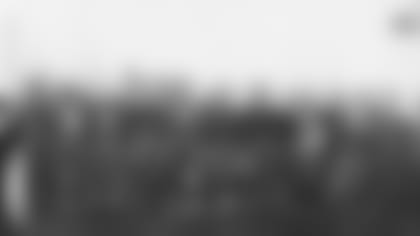
I have no evidence, much less proof, but it suggests to me that it was possible the local players given Acme jerseys at the start of the 1921 season kept them and didn't turn them over to the outsiders brought in over the course of the season to replace them. In turn, because some of those players wound up with the Boosters the next year and other Boosters were former high school teammates of 1921 Packers, it also seemed conceivable that at least some players might have worn year-old Acme jerseys while playing for the Boosters.
As far as I could determine, the Boosters had no sponsor; and even the 1921 Packers weren't outfitted all the same. While I've never come across a picture of a Green Bay Boosters game, it wouldn't surprise me if the players wore a smattering of different jerseys.
Anyway, with those thoughts in mind, I checked to see if Buff Wagner, who had played for the 1920 and '21 Packers, had also played for the Boosters in 1922 and found no evidence that he did. On the other hand, I did find mention of him signing with the Marinette Twins before the 1922 football season. That left open the possibility that Wagner could have played against the Boosters and players who possessed Acme jerseys. But, here again, while I found most, if not all, of the Boosters' game results, I found nothing about them playing Marinette.
As a result, any doubts I might have harbored were alleviated.
What I couldn't determine was what game it was; nor could I be absolutely certain the photos were all of the same game. But following more research, my first guess would be that most, if not all, of the photos were taken during the non-league opener against the Chicago Boosters.
Here's why.
Through the process of elimination, it's all but a cinch the photos weren't taken during one of the last three league home games against Rock Island on Oct. 30, Evansville on Nov. 6 and Hammond on Nov. 13.
The Rock Island game was played in a dense fog that according to The Rock Island Argus, which sent a writer to the game, "engulfed the field." The Evansville game, according to the Press-Gazette, drew the smallest crowd of the season, and there were large empty gaps of seats in the grandstands on both sides of the field. The Hammond game was played on a snow-covered field. There's one picture, where at first glance it looks like there might be snow on the ground, but upon closer examination, it appears to be nothing more than bare sections of the Hagemeister Park infield.
The Oct. 16 Beloit non-league game drew a crowd that might have lined the sidelines and was finished in a downpour, so that would seem to be an unlikely candidate, as well. Ditto for the non-league games against Rockford on Oct. 2, played before only a "fair-sized crowd," according to the Press-Gazette, and the Oct. 9 Chicago Cornell-Hamburgs game played before a "small-sized crowd."
The crowd for the league opener against Minneapolis, "jammed every corner of the field at Hagemeister Park," Calhoun wrote. That was at a time when fans could stand along the sidelines, so that description wouldn't seem to fit either. The Chicago Boosters game, on the other hand, was played "before a crowd which comfortably filled the newly constructed stands," according to Calhoun.
Wagner also started that game at quarterback, so those photos would have been a nice family keepsake.
Ann from Big Island, HI
I was born and raised in Green Bay, and our family has had season tickets since Lambeau Field opened. I'm doing some family history work and wondering if you'd have further light to shed on this. My grandparents, Emerson and Isabel Grebel, lived on Miramar Drive and were neighbors with the Lambeaus and Hutsons. A document states that Emerson played with the eventual Packers of the 1910s. My husband and sons would find this interesting if there was more information.
Let me first explain, those pre-1919 amateur and city teams had no connection to the Packers. There were countless teams in Green Bay from 1910 to 1918. And based on a quick search, I didn't find any mention of Emerson Grebel playing for any of them. That said, I can't definitively state that he didn't play.
Keep in mind, times were different. For example, in bigger cities like Milwaukee and Minneapolis there were hundreds of players who played in organized tackle football leagues on Sundays. In Minneapolis in 1921, for example, there were close to 100 teams with more than 1,600 players in the Park Board Amateur Football Association. The Milwaukee Amateur Football Association had similar participation.
In Green Bay, a much smaller city, there were no real organized leagues in the timeframe you mentioned, and teams were constantly forming and folding. But in 1910, for example, I counted eight that played at least one game and there might have been more. Some years there might have been a team that was recognized as Green Bay's city team but not always.
Actually, after the Packers were born in 1919, those amateur teams and leagues around Green Bay became better organized. In 1933, for example, Allouez and Preble met at City Stadium on Thanksgiving Day to decide the championship of the City Amateur Football League.
That said, your grandfather was an outstanding player at Green Bay East High School from 1905-07, and that was a much bigger deal than the amateur ball that was played when he returned to Green Bay after college. East-West received more extensive coverage in the Press-Gazette and drew bigger crowds at times than Packers-Bears even into the 1920s.
Here was the lead to Jack Rudolphi's Nov. 30, 1956, Press-Gazette story about Grebel's East team from 50 years earlier.
"Remember 'Sunny Jim' Cook? Emerson Grebel? Or "Joe" Hoeffel?"
Deeper into the story, Rudolph explained, "all three were members of East High's first unbeaten and untied, and the only unscored-upon football team in East's 61-year gridiron history – the state campionship claimants of 1906."
Grebel also played at Carroll College. As for Miramar Drive, I grew up there, too, in the 1950s. Lambeau moved to Miramar in the early 1930s but divorced his wife soon after and moved out. Based on Green Bay city directories, Hutson was living there by 1943 and still there in 1949, the last season he was involved with the Packers in an on-field capacity.
Travis from Milwaukee, WI
There have been stories in my family that my great great grandfather, Roland Gabert, played for the Packers in the early times. Would you know anything about him playing with the organization?
Gabert never played for the Packers, but there was a Gabert that started at right end for Sturgeon Bay High School in 1916 when it played Green Bay East, which was led by senior captain Curly Lambeau. From what I could determine, if I found the right Roland Gabert, he would have attended Sturgeon Bay High School around that time.
R.G. from Vernon, WI
I'm hoping you can finally clear up a story for me that my father, Melvin Luckow, told me years ago. Dad was born in Kaukauna in 1903. He only finished the sixth grade. He told me that when this new football team started in Green Bay, it would play teams in the surrounding area, one of them being Kaukauna, which he played for. Dad passed some 40 years ago. Any information you can give me would be great.
Yes, the Packers played the Kaukauna American Legion team in 1920, their second season of existence. The Packers won 56-0 and there was no Luckow listed in Kaukauna's lineup. But a Luckow was listed as one of two other linesmen under head linesman Jim Coffeen. My suspicion is the two linesmen might have been the chain gang. Also, Melvin Luckow was Kaukauna High School's quarterbackk in 1921 and "Deak" – your dad's nickname you wrote – was the quarterback in 1922. That doesn't jive with him dropping out of school after sixth grade. But if that's him, seems like he was a good high school football player.
Gerard from Woodbury, NJ
My mother always said that my grandfather played for the very early Packers after playing football for Ripon College. However, my brief research shows Nicholas Kayser playing for Ripon in 1908, which would have made it unlikely that he played for the Packers 11 years later.
You're right. He didn't play for the Packers. But sounds like he was an outstanding end for Ripon for two years before transferring to the University of Wisconsin. I found a Green Bay Gazette story that said the Badgers wanted him to go out for football based on his play at Ripon, but he decided to focus on his studies in the engineering school. From what I could find it also sounds like your grandfather was an outstanding three-sport athlete at Green Bay West High School in the early 1900s, as well.
Nancy from Bend, OR
My husband's grandfather, James Francois, who played center at East High School with Curly, I also believe played center for the Green Bay city team for a season. I don't see him listed on the rosters for the Acme Packers in 1919 and '20. Did they keep rosters for those city teams?
James played for East High in 1917 and was the backup center but also one of what looks like 15 players for East who got into the East-West game that fall. He played with Raymond "Rummy" Lambeau, Curly's brother. I don't see James listed on East's roster in the fall of 1916, Curly's senior season, but that doesn't necessarily mean he wasn't out for football. We have complete rosters for the Packers going back to 1919 and James is not listed. They were the Indian Packing Packers in 1919 and '20; and the Acme Packers for only one league game in 1921.
Kyle from Geneva, IL
Over the years, my grandpa mentioned that they scrimmaged against the Packers when they trained at Lakeland College. Was there a time when the Packers trained or certain players trained at Lakeland? I'm assuming that he attended Lakeland around 1953-57.
Your grandfather played tackle and was a four-year letterman at Lakeland, located in Sheboygan, Wis. But, no, the Packers never trained at Lakeland. His last football season was 1956, and the Packers trained at what's now UW-Stevens Point from 1954-56 and at Grand Rapids, Minn., in 1953. The only connection I could find is that Abe Stuber, an assistant coach with the Packers in 1956, spoke at Lakeland's athletic banquet following your grandfather's senior season.



